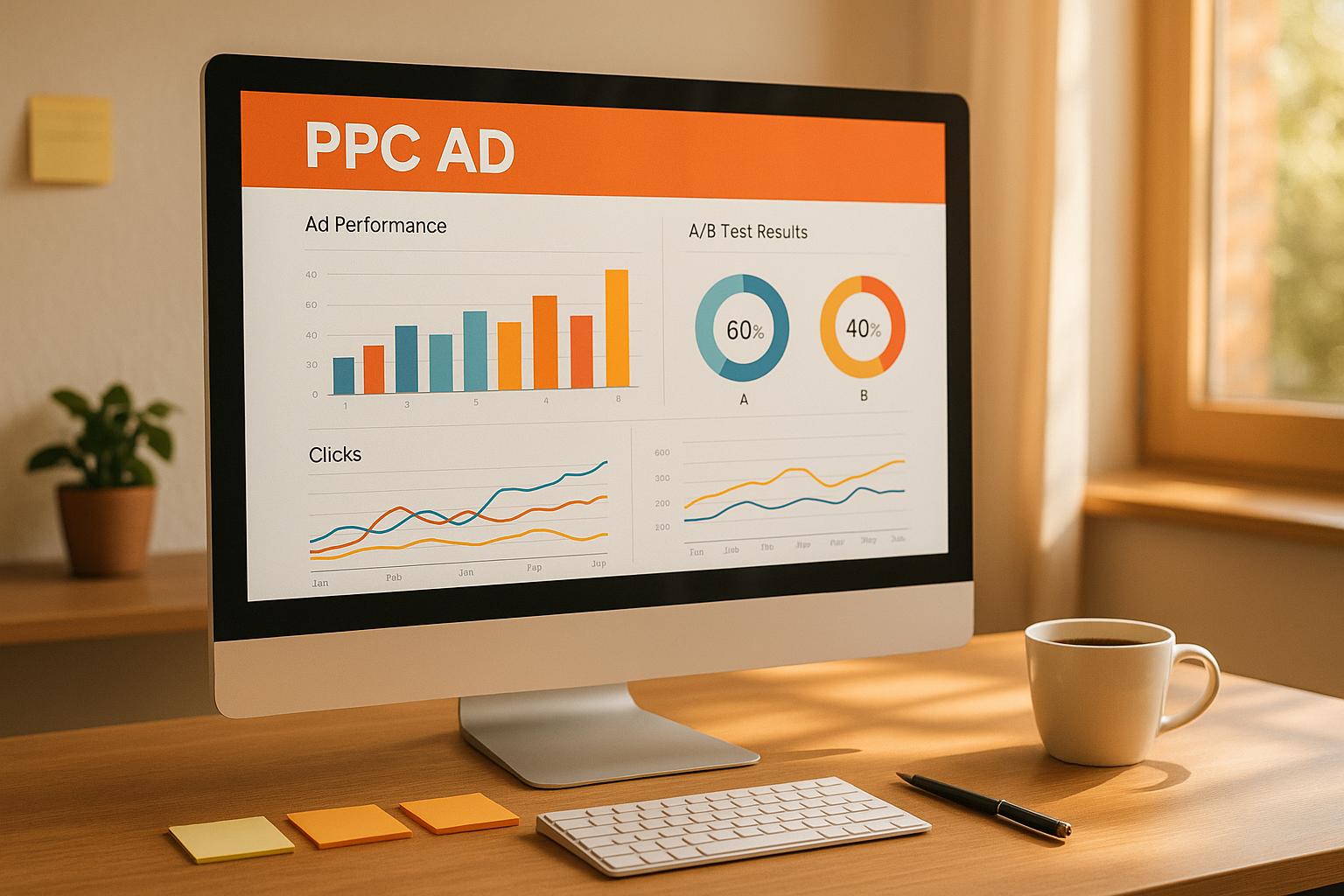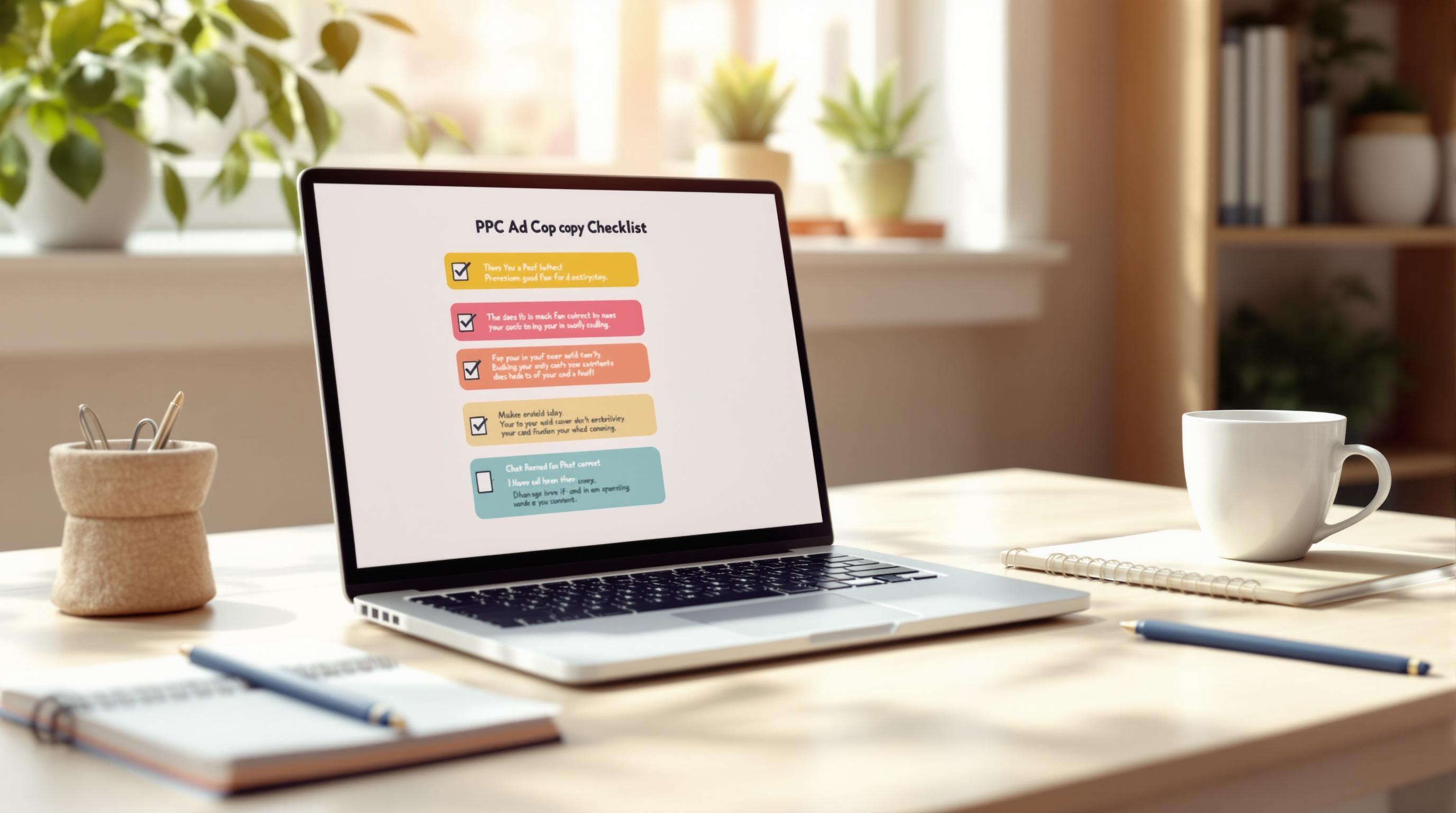Key Metrics You Need to Know:
- Click-Through Rate (CTR): Measures how many people click your ad after seeing it. High CTR = engaging ads.
- Cost Per Click (CPC): Tracks how much you pay for each click. Lower CPC = better budget efficiency.
- Conversion Rate: Shows how many clicks lead to actions like purchases or sign-ups. Higher rate = effective targeting.
- Return on Ad Spend (ROAS): Calculates revenue generated for every dollar spent. Aim for at least 3:1.
- Cost Per Acquisition (CPA): Tracks the cost of gaining a customer. Keep CPA aligned with your profit margins.
- Quality Score: Google’s rating of ad relevance, keyword quality, and landing page experience. Higher score = lower costs.
Why These Metrics Matter:
- Pinpoint what’s working and what isn’t.
- Optimize ad spend and improve ROI.
- Refine targeting, messaging, and landing pages.
Quick Comparison of Key Metrics:
| Metric | Purpose | Impact |
|---|---|---|
| CTR | Measures engagement | Boosts ad relevance and visibility |
| CPC | Tracks ad cost per click | Controls budget efficiency |
| Conversion Rate | Measures click-to-action ratio | Improves campaign effectiveness |
| ROAS | Tracks revenue per dollar spent | Maximizes profitability |
| CPA | Tracks cost per new customer | Ensures sustainable growth |
| Quality Score | Rates ad relevance and quality | Lowers costs, improves placement |
Focus on these metrics to make smarter decisions, optimize performance, and drive better results for your PPC campaigns.
Essential PPC Metrics to Monitor
Understanding Click-Through Rate (CTR)
Click-Through Rate (CTR) measures how often people click your ad after seeing it. For instance, a 4% CTR means 40 clicks from 1,000 impressions. A strong CTR indicates your ad resonates with your audience. Plus, a higher CTR can improve your Quality Score, which helps boost your ad rank and lower your Cost Per Click (CPC).
| CTR Component | Impact on Campaign |
|---|---|
| Ad Relevance | Affects Quality Score |
| Keyword Match | Improves targeting accuracy |
| Ad Position | Influences visibility |
| Ad Copy Quality | Encourages user engagement |
While CTR shows how well your ad grabs attention, CPC tells you how much it costs to get that attention.
What Is Cost Per Click (CPC)?
Cost Per Click (CPC) is the actual amount you pay each time someone clicks your ad. It’s a key factor in determining how efficiently your budget is being used. CPC varies based on factors like competition, Quality Score, and your bidding strategy.
Balancing CPC is crucial. For example, if you spend $500 on 250 clicks, your average CPC is $2. By keeping CPC in check, you can maximize reach without overspending. Monitoring and adjusting CPC ensures your ads remain cost-effective while maintaining strong visibility.
Once users click, the next metric to watch is how many of those clicks lead to meaningful actions - this is where Conversion Rate comes in.
How to Measure Conversion Rate
Conversion Rate shows how well your ads turn clicks into actions, like purchases or sign-ups. To calculate it, divide the number of conversions by total clicks, then multiply by 100. For instance, if 50 people make a purchase from 1,000 clicks, your conversion rate is 5%.
Several factors influence conversion rates:
- Landing page relevance: Does the page match the ad content?
- Website performance: Is the site fast and easy to navigate?
- Calls-to-action: Are they clear and compelling?
- Mobile experience: Is your site optimized for mobile users?
- Trust signals: Do you have secure payment options or reviews?
Improving conversion rates often involves refining both your ads and landing pages. Testing various elements, like headlines or layouts, can lead to better results. When you pair a high CTR with a solid conversion rate, it’s a sign your PPC campaign is attracting and converting the right audience effectively.
Advanced PPC Metrics for Better Insights
What Is Quality Score?
Quality Score evaluates how well your PPC campaigns align with user intent and deliver a good experience. It’s based on three main factors: ad relevance, keyword quality, and landing page experience.
| Quality Score Component | How It Affects Your Campaign |
|---|---|
| Ad Relevance | Matches your ad to what users are searching for |
| Keyword Quality | Impacts ad placement and visibility |
| Landing Page Experience | Affects conversions and cost efficiency |
Why does this matter? A higher Quality Score can significantly lower costs. For instance, an ad with a score of 8 may pay 50% less per click than one with a score of 4, even competing for the same position.
Understanding Return on Ad Spend (ROAS)
While Quality Score focuses on the efficiency of your ads, ROAS highlights their financial impact. ROAS measures how much revenue your ads generate for every dollar spent. For example, if you spend $5,000 on ads and earn $15,000 in revenue, your ROAS is $3. This metric helps pinpoint which campaigns deliver the best returns, so you can fine-tune your budget for maximum profit.
"Quality Score is crucial because it directly impacts your ad rank and CPC. A higher Quality Score can lead to better ad positions and lower costs per click, making your campaigns more efficient and effective." - MatchCraft, AI-Powered Ad Optimization Solutions.
Breaking Down Cost Per Acquisition (CPA)
CPA focuses on the cost of gaining each customer through your PPC campaigns. For example, if you spend $10,000 on ads and gain 100 customers, your CPA is $100.
When evaluating CPA, keep these factors in mind:
- Industry benchmarks: Compare your CPA to competitors in your field.
- Customer lifetime value: Ensure the cost to acquire a customer is worth their long-term value.
- Sales funnel issues: Identify weak spots like poor landing pages or a clunky checkout process.
How to Track and Improve PPC Metrics
Tools to Track PPC Metrics
Using tools like Google Ads and Google Analytics is essential for tracking campaign performance and user behavior. For deeper insights, third-party platforms can help analyze competitors and provide advanced reporting options. Combining these tools gives you a clear picture of performance and areas to refine.
| Tool Type | Function | Metrics Tracked |
|---|---|---|
| Google Ads & Analytics | Track campaigns and user behavior | CTR, CPC, Conversion Rate |
| Third-Party Platforms | Analyze competitors and trends | Market Opportunities, Performance Benchmarks |
Improving Metrics Through Optimization
After identifying weak spots with these tools, focus on making data-driven improvements. For example, adjusting bids based on keyword results can help manage costs. Incorporating long-tail keywords can refine your targeting while keeping expenses in check.
To enhance landing page performance, prioritize these elements:
- Clear, engaging headlines with relevant content
- Fast load times (aim for under 3 seconds)
- Strategic CTAs that guide users effectively
- Mobile-friendly designs for seamless user experiences
These tweaks can make a noticeable difference, especially when applied to specific goals like boosting ROAS.
Example: Boosting ROAS with Targeted Ads
Targeted ad strategies can make a big impact on ROAS. Instead of casting a wide net, focus on audience groups with a higher likelihood of converting. Allocate more budget to high-intent keywords and retarget users who have already shown interest.
| Targeting Strategy | Impact on ROAS |
|---|---|
| Long-tail Keywords | More relevant clicks, lower CPC |
| Retargeting Previous Visitors | Higher chance of conversions |
| Geographic Targeting | Smarter budget use based on location |
sbb-itb-89b8f36
KPI's For PPC - Most Important Things To Measure For PPC Campaigns
Comparing PPC Metrics to Guide Your Strategy
Analyzing PPC metrics side by side helps you spot trade-offs and decide where to focus for better results. Knowing how these metrics interact is critical for improving campaign outcomes and maximizing ROI.
CTR vs. CPC: Balancing Engagement and Cost
Click-Through Rate (CTR) and Cost Per Click (CPC) are closely tied to campaign efficiency. Your goal is to strike a balance between driving engagement and managing costs.
| Aspect | Goal | Ideal Approach |
|---|---|---|
| CTR Focus | Boost engagement and relevance | Support steady growth |
| CPC Focus | Keep costs under control | Optimize performance |
| Combined | Visibility within budget | Aim for long-term gains |
Using long-tail keywords can often help you achieve higher CTRs while keeping CPC low. These keywords tend to have less competition and attract users with clear intent.
ROAS vs. CPA: Comparing Profitability and Acquisition Costs
Return on Ad Spend (ROAS) and Cost Per Acquisition (CPA) offer complementary insights. Together, they help shape smarter budget and campaign strategies.
| Metric | Best Use | Key Insight |
|---|---|---|
| ROAS | E-commerce and sales campaigns | Revenue per ad dollar |
| CPA | Lead generation and conversions | Cost per new customer |
| Combined | Overall performance optimization | Profitability benchmarks |
A healthy ROAS (aim for at least 3:1) paired with a CPA that stays within your acceptable range ensures sustainable growth and profitability.
These metrics help guide decisions like:
- Allocating budgets across campaigns
- Choosing the right keywords and adjusting bids
- Refining ad copy for better performance
- Sharpening your target audience
The secret lies in finding the right balance for your business goals and market dynamics. By aligning these metrics, you can craft strategies that deliver results. Up next, we'll dive into how to apply these insights directly to your campaigns.
Conclusion: Using PPC Metrics to Improve Campaigns
Key Takeaways
Making sense of PPC metrics is essential for making informed decisions. Metrics like CTR, CPC, ROAS, and CPA help balance engagement and profitability, giving marketers the tools to fine-tune campaigns. By keeping a close eye on these numbers, you can spot areas for improvement and allocate your budget wisely.
| Focus Area | Metrics | Impact |
|---|---|---|
| Campaign Efficiency | CTR + CPC | Improve relevance and control costs |
| Financial Performance | ROAS + CPA | Boost profitability and efficiency |
| Quality Adjustments | Quality Score | Better placement, lower costs |
Knowing these metrics is just the start - what matters is how you use them to refine and improve your campaigns. With that foundation, let’s dive into strategies to elevate your PPC performance.
Steps to Elevate Your PPC Campaigns
Begin by assessing your current performance. Establish baseline metrics and set realistic improvement goals based on your industry and past results.
Regular check-ins are essential. Review your key metrics weekly to identify trends and make timely adjustments. A major focus should be on improving your Quality Score, which can lead to better ad placements and cost savings.
Here are three strategies to help you make meaningful improvements:
- Set up conversion tracking: Make sure every conversion, even smaller ones, is tracked accurately.
- Improve landing pages: Match your landing page content closely with your ad messaging to boost both Quality Score and conversions.
- Sharpen audience targeting: Use retargeting and lookalike audiences to zero in on the right users.
PPC success is all about staying consistent. Keep tracking, refining, and focusing on metrics tied to your business goals. By turning data into actionable insights, you’ll be able to make smarter optimizations and see real, measurable results.


